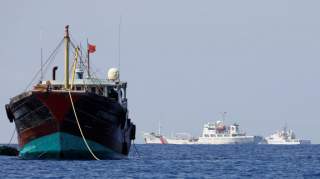Understanding and Defeating China’s Maritime Insurgency in the South China Sea
China is treating ocean space in the South China Sea as if it were land territory. How should the United States?
A maritime counterinsurgency strategy would seek to win the battle of legal regimes in the decisive domain, namely, in the adherence and behavior of civilian mariners. And like counterinsurgency efforts on land, it would require the use of U.S. and allied power across a spectrum of military and non-military realms. Under maritime counterinsurgency, protective escort operations at sea would be coupled with simultaneous lines of effort to politically harden Southeast Asian governments and economies against malign Chinese influence, along with the development and deployment of high-end warfighting forces to deter large-scale kinetic Chinese aggression against U.S. allies along the first island chain.
The key objective of maritime counterinsurgency is to render Chinese forces in the South China Sea irrelevant in circumstances short of war, just as China has made U.S. forces irrelevant over the past several years. Provided that the United States and its allies can successfully balance between maintaining deterrence at the high end of the conflict spectrum while executing maritime counterinsurgency at the low end, China’s expensive new instruments of coercion would be outmaneuvered and reduced to impotence if civilians under U.S. and allied protection were made to feel confident enough to pay no heed to Chinese admonitions and their menacing threats of harm.
The challenge in Washington and allied capitals, is to mobilize the vibrant community of knowledge in this space to determine how maritime counterinsurgency can best be made operationally viable and cost-sustainable over the long term. If history is any guide, this will be a campaign that must be continued for however long it takes the Chinese leadership to recognize the inability of its maritime insurgency to overturn the rule of prevailing international law by sub-kinetic coercion, as well as the very real benefits to China of accepting and abiding by the existing system based on the Freedom of the Sea. Once the outstanding operational questions are successfully answered by the strategic communities in the United States and its partners, maritime counterinsurgency has the potential to win a decisive and much-needed victory for U.S. and allied arms and the rules-based liberal international order they defend.
Hunter Stires is a Fellow with the U.S. Naval War College’s John B. Hattendorf Center for Maritime Historical Research and works in a non-resident capacity on maritime strategy with the Center for a New American Security. He is a freelance contributor to The National Interest and is recently the co-author of “China is Waging a Maritime Insurgency in the South China Sea. It's Time for the United States to Counter It.”
Image: Reuters

